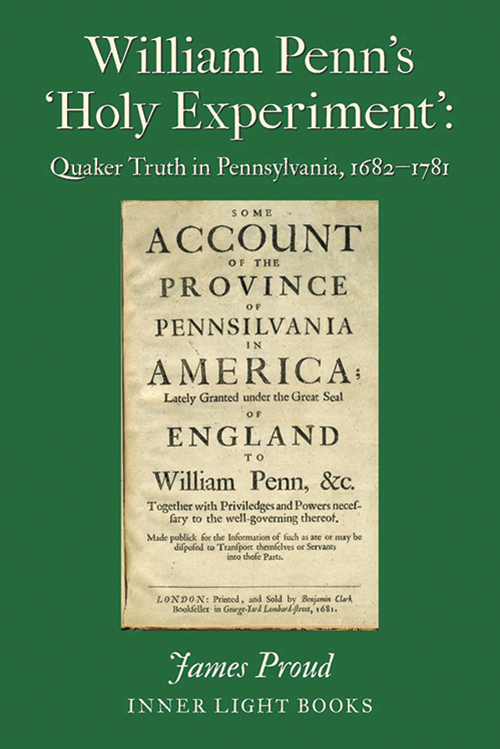
William Penn’s “Holy Experiment”: Quaker Truth in Pennsylvania, 1682–1781
Reviewed by Thomas Hamm
August 1, 2020
By James Proud. Inner Light Books, 2019. 522 pages. $50/hardcover; $35/paperback.
James Proud, a retired attorney and an Episcopal priest, has a fondness for Friends. A decade ago, he edited a collection of Woolman’s writings titled John Woolman and the Affairs of Truth, also published by Inner Light Books. Now he has taken on the challenge of trying to understand how Pennsylvania did—and did not—live up to its founder William Penn’s vision of it as a “Holy Experiment.”
Most of Proud’s story will be familiar to historians and historically minded Friends. Proud opens with an overview of Quakerism in England before 1682, then proceeds to an outline of William Penn’s life. Penn, the son of an admiral, was an unlikely convert to Quakerism, but once convinced in 1667, he emerged as a prolific writer, scrappy debater, and talented preacher. Nevertheless, he remained that rarest of animals: a Quaker aristocrat and courtier. His court connections would prove a mixed blessing. On one hand, they led to King Charles II granting him the colony that Penn wanted to name “Sylvania,” or woodland, but which the king insisted be called “Pennsylvania,” in honor of the admiral. On the other hand, after the Glorious Revolution overthrew Penn’s friend James II in 1688, Penn found much of his political influence gone and himself even in danger of treason charges.
While Proud does give some attention to familiar themes in the establishment of Pennsylvania, such as religious freedom, his focus is on more contemporary concerns, namely relations with Native American people and slavery in the colony. He credits Penn with good intentions in negotiating in good faith with the Leni Lenape (or Delaware), while also noting that epidemic diseases introduced by Europeans had so reduced their numbers that they were ceding largely unoccupied lands. Proud does not spare later generations of White Pennsylvanians, Quaker and non-Quaker, for not following the founder’s example. Penn’s chief agent, James Logan, who built a considerable fortune through the Indian trade and land speculation, emerges as a particular villain, cheating not only Native Americans but the Penn family as well. And William Penn’s sons, none of whom shared their father’s vibrant Quaker faith, saw their colony not as a “holy experiment,” but as a source of revenue for the aristocratic lifestyle they wished to lead in England.
Proud sees the introduction of slavery into Pennsylvania as irreconcilable with any vision of a Christian or Quaker society. He is frank in acknowledging how involved with slavery and the slave trade Pennsylvania Friends were, and takes evident pleasure in tracing the growth of antislavery feeling among Friends and in the colony. He also acknowledges Penn’s personal slaveholding, which he sees as a moral failure, although not expressing that as strongly as some contemporary Friends would.
Proud’s work has a number of strengths. It is based on wide-ranging research in primary sources, and his conclusions are usually judicious and well-supported. Particularly valuable are the 11 appendices, which include useful compilations, like comparative lists of the speakers of the Pennsylvania Assembly and clerks of Philadelphia Yearly Meeting as well as documents like Israel Pemberton’s prefatory epistle to the Philadelphia Yearly Meeting men’s minute book. There are also notes, maps, and an index.
If the book has a weakness, it is its failure to engage with recent scholarship, especially on Native Americans in Pennsylvania, such as Peter Silver’s Our Savage Neighbors (2008); Amy C. Schutt’s Peoples of the River Valleys (2007); or the work of the most recent Penn biographer, Andrew R. Murphy (2018). Friends interested in Penn and Pennsylvania will find this a readable and generally reliable work.
Thomas Hamm is a member of West Richmond (Ind.) Meeting, and a professor of history and director of Special Collections at Earlham College. Several of his ancestors were members of the Pennsylvania Assembly between 1682 and 1720.


